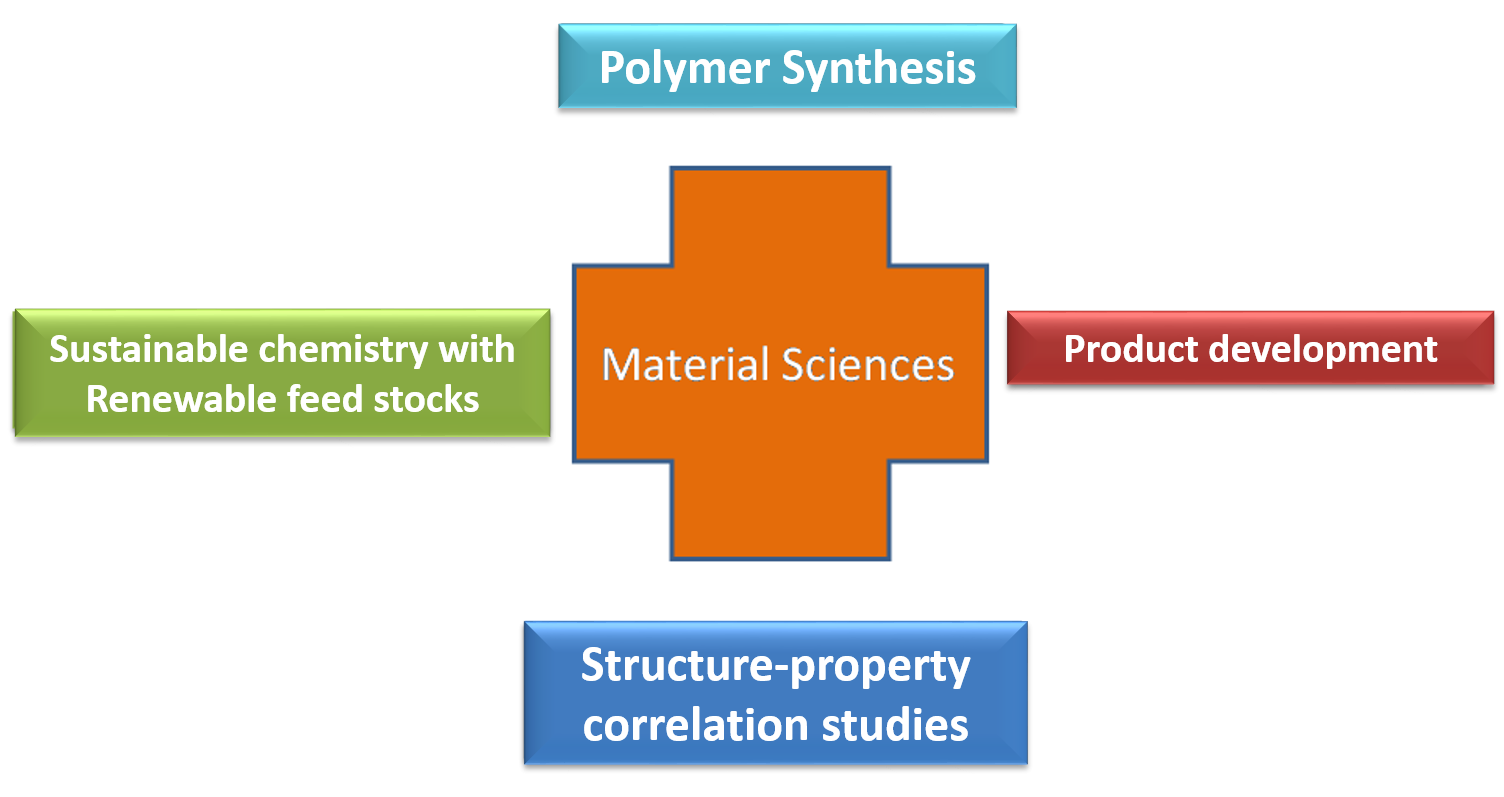Dr Suresh K I

- Dr Suresh K I
- Chief Scientist
- kisuresh.niist@csir.res.in
- 0471-2515491
- +919652470482
- PhD Applied Chemistry, IIT (ISM), Dhanbad.
- M.Tech Polymer Technology, CUSAT, Kochi.
- M.Sc. Polymer Chemistry, MG University, Kottayam.
- BSc Chemistry, MG University, Kottayam.
- Polymer synthesis and characterization, mechanistic studies, product development, and structure-property relationship studies. Emulsion Polymerization, Latex Film Formation approach to nanocomposites with controlled surface, morphology, thermal and rheological properties.
- New monomers and polymers from renewable resources as sustainable feedstocks for the chemical industry.
- Controlled free radical polymerization techniques for synthesis of well-defined polymers.
- 2008-Marie Curie International Incoming Fellowship (MCIIF) of the European Commission under the 7th Framework programme.
- 2001- CSIR (India) - DAAD (Germany) Sandwich model fellowship.
- 1990 - M.Sc, First Rank in university with distinction.
- 1988 - B.Sc, Prof. N. I. Joseph memorial gold medal for securing highest marks.
The research activities are summarized in the figure below:

(a) Sustainable chemistry with renewable feedstock’s.
There is a strong demand for replacing petroleum derived raw materials with renewable, plant-based ones in the production of polymeric materials, from the social and environmental viewpoints. Vegetable oils are ideal, alternative feedstock for chemicals as they are derived from plant, or animal resources and found in abundance around the world. Even though the triglyceride oils have been traditionally used in various applications, like coatings, inks, and adhesives, the value addition has been low and often, the properties were inferior to the petroleum based products. Cardanol, isolated from Cashew Nut shell Liquid, is another important renewable resource. Cardanol derivatives have been used in polyurethane preparation in recent years and products with better thermal, mechanical and chemical characteristics were obtained. The research on cardanol is focused on the development of novel polyurethane polyols, polymerizable acrylates, surfactants and structure-property relationship study of the synthesized polymers. Following appropriate derivatization strategies, liquid low viscosity polyols with a range of hydroxyl value and other polymerizable monomers were developed and the synthesized polymers exhibit enhanced thermal stability and mechanical properties. However, the development of materials for future applications would require polymeric materials with tailored structure, functionality and molecular weight etc. New methodologies for making cardanol based polymers and copolymers of controlled mol.wt., polydispersity were explored using techniques like, atom transfer radical polymerization (ATRP) and RAFT polymerization along with its application development. Some relevant publications are:
- Morphological, Physico-Chemical and Structural Characterization of Gum Kondagogu (Cochlospermumgossypium): A Tree Gum From India.
V.T.P. Vinod, R.B. Sashidhar, K.I. Suresh, B. Rama Rao, U.V.R. VijayaSarathi T. P. Rao.
Food Hydrocolloids 22: 899-915, 2008. - Synthesis of novel crosslinkable polymers by Atom Transfer radical polymerization of Cardanyl acrylate
K.I.Suresh*, M. Jaikrishna.
J.Polym.Sci.Part A:Polym.Chem. 2005, 43, 5953-5961. - Synthesis, Structure and properties of novel polyols from cardanol and developed polyurethanes.
K.I.Suresh*, V.S.Kishanprasad.
Ind. Engg. Chem. Res, 2005,44, 4504-4512. - Study on blending of millable polyurethane derived from castor oil with natural rubber.
K.I. Suresh and E.T. Thachil,
Die Ange Wandte makromolekulare chemie1995,224, Nr.3887,55-60. - Synthesis and curing of millable polyurethanes based on castor oil.
K.I. Suresh, and E.T. Thachil,
Die Ange Wandte makromolekulare chemie1994,218, Nr.3812,127-133.
(b) Emulsion polymerization approach to Nanostructured Materials and Nanocomposites
Emulsion polymerization is an environment friendly process, widely employed in the preparation of polymeric binders for adhesives and coatings. Due to the applied nature of the process it is of great importance to make polymers with tailored structure & properties as well as in fundamental research. Emulsion polymerization study was focused on understanding of particle stabilization and polymerization kinetics as a means to achieve morphology control in seeded emulsion polymerization. Using the technique nanocomposite of fluoropolymers with polyacrylates has been prepared that are important as photonic materials. To probe the interior morphology of the particles and films transmission electron microscopy was used while atomic force microscopy (AFM) probed events during film formation of the core-shell latex particles. Structure property correlation of final film properties by dynamic mechanical analysis, static light Scattering and Forced Rayleigh Scattering was carried out. Synthesis and evaluation of new additives for emulsion polymerization was also studied.
The application of emulsion polymerization for the preparation of polymer dispersed liquid crystals and Cholesteric liquid crystals are also being studied. The cholesteric systems have attracted special interest as result of their selective reflection of light that is caused by the helical structure of the mesophase. Cholesteric mesophases can be obtained by mixing a nematic host with small amounts of a chiral dopant. The reflected wavelength depends on the viewing angle, with increasing viewing angle a blue shift can be observed. This effect, called color flop, is the origin for the increasing interest in this class of materials. Anisotropic, permanently fixed cholesteric networks find various applications e. g. as holographic writing or data recording materials, polarizers, screen printing inks (Ultraking® Paliocolor® by BASF AG), and can be further processed into pigment particles for car paints. These organic color flop pigments are distinguished from inorganic pigments by a high contrast color flop and excellent color brilliance. Our research is focused on development of polymerizable mesogens and chiral dopants along with the UV curing studies as well as their synthesis through emulsion polymerization.
- Effect of seed characteristics on morphology development in Poly (n-butyl acrylate)-Poly (butyl methacrylate) Core-Shell Dispersions.
K. I.Suresh and EckhardBartsch127, 208-216, 2013.
Journal of Applied Polymer Science. - Synthesis and Micellization Properties of New Anionic Reactive Surfactants Based on Hydrogenated Cardanol.
K. I. Suresh, G. Foerst, R. Schubert,and E. Bartsch
Journal of Surfactants & Detergents, 15, 207-215, 2012. - Viscoelastic properties of polyacrylonitrile terpolymers during thermo-oxidative stabilization (cyclization).
K. I. Suresh*, K. Saji Thomas, B. S. Rao, C.P.R. Nair.
Polymers for Advanced Technologies 19, 831-837, 2008. - Synthesis, morphology and rheological behaviour of fluoropolymer - Polyacrylate nanocomposites.
K.I.Suresh, T.Pakula, E.Bartsch
Macromol. React. Eng. 1,253-263, 2007. - Viscoelastic and damping characteristics of poly (n-butyl acrylate)-poly (n-butyl methacrylate) semi- IPN latex films.
K.I.Suresh*, S.Vishwanatham and E.Bartsch
Polym. Adv. Techno 18, 364-372, 2007. - Mechanistic studies on Particle nucleation in the batch emulsion polymerization of n-butyl acrylate containing multifunctional monomers.
K.I.Suresh, J.Othegraven, K.V.S.N. Raju, and E. Bartsch.
Colloid Polymer Science283, 49-57, 2004. - Effect of Copolymer composition on the dynamic mechanical and thermal behavior of n-butyl acrylate-acrylonitrile copolymers.
K.I.Suresh*, B.S.Sitaramam, K.V.S.N. Raju,
Macromol. Mat. Engg. 288(12), 980-988, 2003.
(C) Graphene - polymer nanocomposites
The unique properties of 2D graphene nanostructures like graphene oxide (GO) and reduced graphene oxide (rGO) are utilized for the development of technologically viable devices, chemical and biological sensors, electronics, cancer drug delivery, imaging systems, and better antibacterial agents.The numerous reports on the biomedical applications of GO & rGO encouraged us to investigate their novel biological properties for the development of new treatment strategy for several diseases using this nanomaterial. In this context, angiogenesis is a biological process that helps to make new blood vessels from the pre-existing vasculature and it plays an important therapeutic role for the treatment of cancer, and cardiovascular related disease (CVD). Consequently, the significant pro- and anti-angiogenic properties of GO & rGO depending on their concentration and formation of reactive oxygen species (ROS) have been demonstrated.(Adv. Healthcare Mater. 2015, 00, 1-10)
Hybrid materials of conducting polymers with two dimensional nano fillers like graphene have received significant research attention in the past few years. These materials are studied for various applications like sensors, super-capacitors, intelligent membranes, separation devices, photovoltaic devices, micro optic devices, new catalysts and so on. Poly(3-hexylthiophene) (P3HT) is one of the widely investigated semiconducting polymer, partly because the hexyl group is sufficiently long to confer good solubility to the prepared polymer, without diluting the conjugated backbone and posses excellent stability to weathering and degradation. Moreover, the band-gap of polythiophene derivatives can be modulated through molecular design to make a polymer whose absorption matches with the maximum photon flux of the solar spectrum and to improve the photo response voltage.Since the pristine graphene is zero band gap, the introduction of functional groups through oxidation opens up the band gap of oxidized graphene. The effect of GO nanostructure size and quantity (various wt %) on the chemical oxidative polymerization of 3-hexylthiophene towards the preparation of P3HT-GO nanocomposites was studied.(Polymer Composites- 2015)
- Surface-initiated Atom Transfer Radical Polymerization (SI-ATRP) from Graphene Oxide: Effect of Functionalized Graphene sheet (FGS) on the Synthesis and Material Properties of PMMA Nanocomposites.
N. Rajender and K.I. Suresh*
Macromolecular Materials & Engineering 2016,301,81-92. - Effect of Graphene Oxide (GO) Size and Structure on Synthesis and Optoelectronic Properties of Hybrid GO-Poly (3-Hexylthiophene) Nanocomposites.
S. Pavithra, N. Rajender, M. Venkateswara Reddy, K. Murugan and K. I.Suresh*
Polym Compos.(2015) doi: 10.1002/pc.23646 - Graphene Oxides Show Angiogenic Properties.
S. Mukherjee, P. Sreeram, A. K. Barui, S. K. Nethi,V. Veeriah, S. Chatterjee, K. I. Suresh, and C. R.Patra
Adv. Healthcare Mater. 2015, 4, 1722-1732 (I.F.-4.88) - Synthesis, Characterization and Optical Properties of Graphene Oxide - Polystyrene Nanocomposites.
K.I.Suresh,* Chithambaram K., Vinod V.T.P, Rajender N, Venkateshwara Reddy M. and M.Černík,
Polymers for Advanced Technologies, 2015, 26, 214-222.
 |
Ms. Devikrishna K.S., JRF(UGC) Research Topic: Biobased polyols & Polyurethane dispersions Email ID: devikrishna413@gmail.com |
 |
Ms. Bavya V, JRF(KSCSTE) Research Topic: Biobased Ionic Liquids and Nanocomposites Email ID: bavyasreedharan@gmail.com |
Alumni (PhD)
| Sl.No. | Student Name | Thesis Title | Status | Year of Completion |
|---|---|---|---|---|
| 1. | Dr. M.Venkateshwara Reddy | Studies on the synthesis and optoelectronic properties of polythiophene and its copolymer dispersions via emulsion polymerization | Awarded | 2016 |
| 2. | Dr. N.Rajender | Graphene polymer Nanocomposites: effect of process route on the synthesis, properties and performance characteristics. | Awarded | 2019 |
Dissertation Students
| No. | Student Name | University | Year guided | Research Degree | Dissertation Title |
|---|---|---|---|---|---|
| 1. | Hajra Bano | Osmania University | 2018-2019 | M.Pharm | Synthesis, characterization and evaluation of CNSL derivatives for pharmaceutical applications |
| 2. | Nimmy Davis | M.G.University | 2019 | M.Sc Polymer Science | Synthesis and characterization of amphiphilic PEG modified graphene oxide (GO) and its Evaluation in the dispersion polymerization of Styrene |
| 3. | Namita Chandran | CIPET-Kochi | 2017-2018 | MSc Biopolymer Science. | Reactive surfactants for emulsion polymerization from cardanol and its copolymerization. |
| 4. | Jesiya Marie George | CIPET-Kochi | 2017-2018 | MSc Biopolymer Science. | Cardanol modified phenolic resin-Synthesis and Characterization. |
| 5. | Sumi M.Nair | CIPET-Kochi | 2016-2017 | M.Sc Biopolymer Science | Copolymerization Studies of Polymerizable Monomers from Cardanol: A Renewable Resource |
| 6. | B. Harpriya | Bharathiar University | 2016-2017 | M.Sc. Nanoscience & Technology | Development of magnetic polymer Nanocomposites. |
| 7. | Abhilash. V | Sri Jayachama-rajendra College of Engineering (SJCE), Mysuru | 2014-2015 | M.Tech Polymer Science & Technology | Studies on the Development of Graphene-Polymer Nanocomposite Membranes For Water Purification |
| 8. | S. Pavithra | Bharathiar University | 2013-2014 | M.Sc.Nano science & Technology | Studies on Effect of Graphene oxide (GO) Nanostructures on the Synthesis & Properties of Poly(3-hexylthiophene) Nanocomposites |
| 9. | Jeemol P. Gopi | M.G.University | 2013-2014 | M.Sc. (Polymer Science) | Studies on Synthesis of Phenalkamine Curing Agent from Cardanol and Its Effect on Cure Characteristics and Properties of Epoxy Resin |
| 10. | Mr.K.Chithambaram | Cochin University of Science & Technology | 2012- 2013 | M.Tech (Polym.Techn) | Preparation and Characterization of Graphene -Polymer Nanocomposites |
| 11. | Ms.Saranya S. Kumar | Mahatma Gandhi University | 2013 | B.Tech (Polymer Engg.) | Cardanol Modified Phenolic Resins: Synthesis, Characterisation and Moulding Compositions |
| 12. | M.Lokesh Kumar | Nizam College (autonomus) Osmania University | 2012- 2013 | M.Sc Chemistry (integrated) | Phenolic vs Polybenzoxazines : Comparative study on Synthesis, Curing, Adhesion and Moulding properties. |
| 13. | Ms.Vishnupriya | Kakatiya University | 2012 | M.Sc Chemistry (integrated) | Studies on synthesis of epoxidized cardanol using m-choloroperbenzoic acid |
| 14. | Mr.M.G.Harik-rishnan | NIT, Kozhikode | 2011-2012 | M.Sc (Tech) | Polyurethane-polyacrylate hybrid dispersions based on Renewable polyols |
| 15. | Mrs. Renjini Manjush | Cochin University of Science & Technology, Cochin | 2010 June-2011 May | M.Tech Polymer Technology | Comparative studies on grafting of acrylonitrile on to Natural rubber latex by conventional and controlled radical polymerization |
| 16. | Rajeevan K | Kannur University, Kerala. | Jan-June 2008 | M.Sc (Material Science ) | Studies on Synthesis, characterization and Emulsion Polymerization of side chain Liquid crystalline monomers |
| 17. | Nanda kishore | S.K.University, Ananthapur | Feb-July 2008 | M.Sc.(Polymer Science) | A comparative study of the effect of surfmer structure on reactivity in emulsion polymerization |

